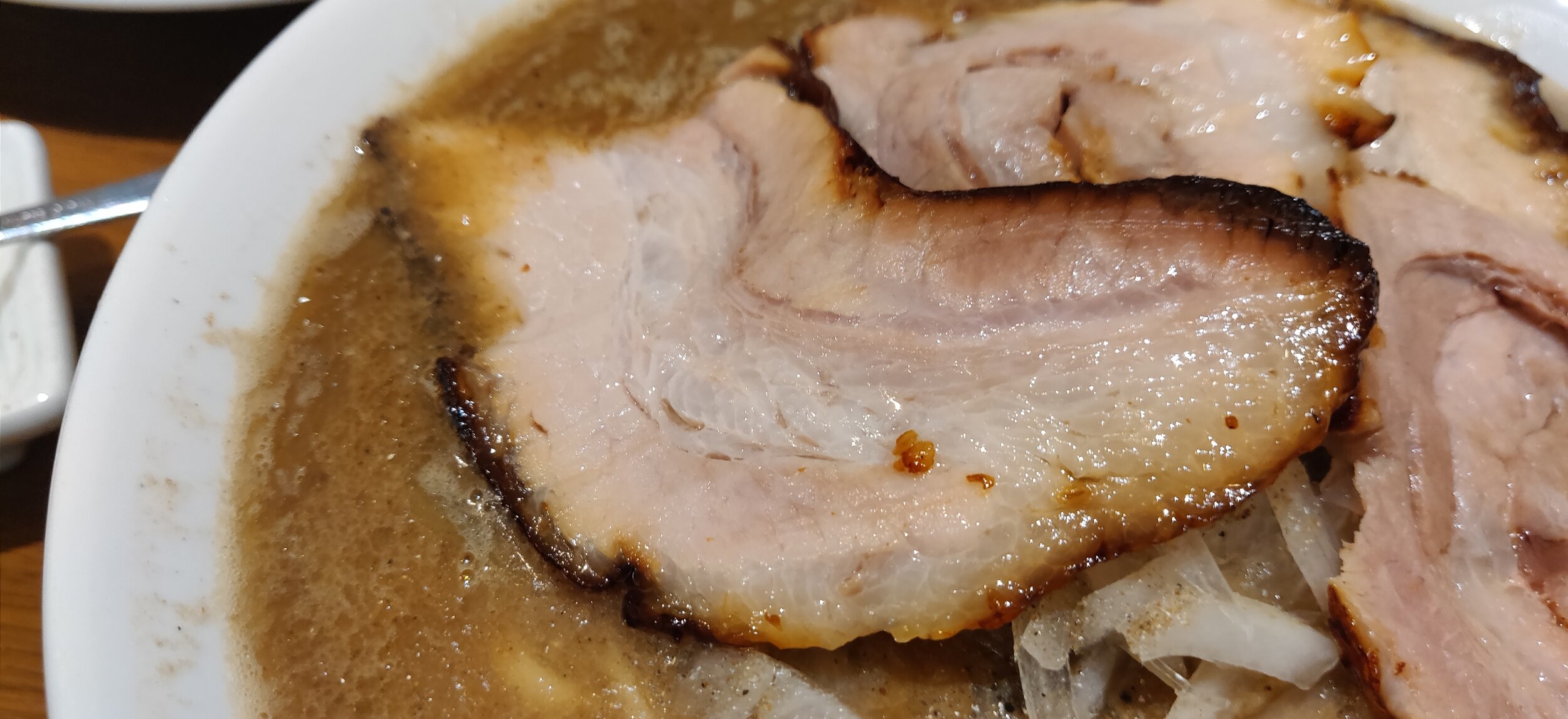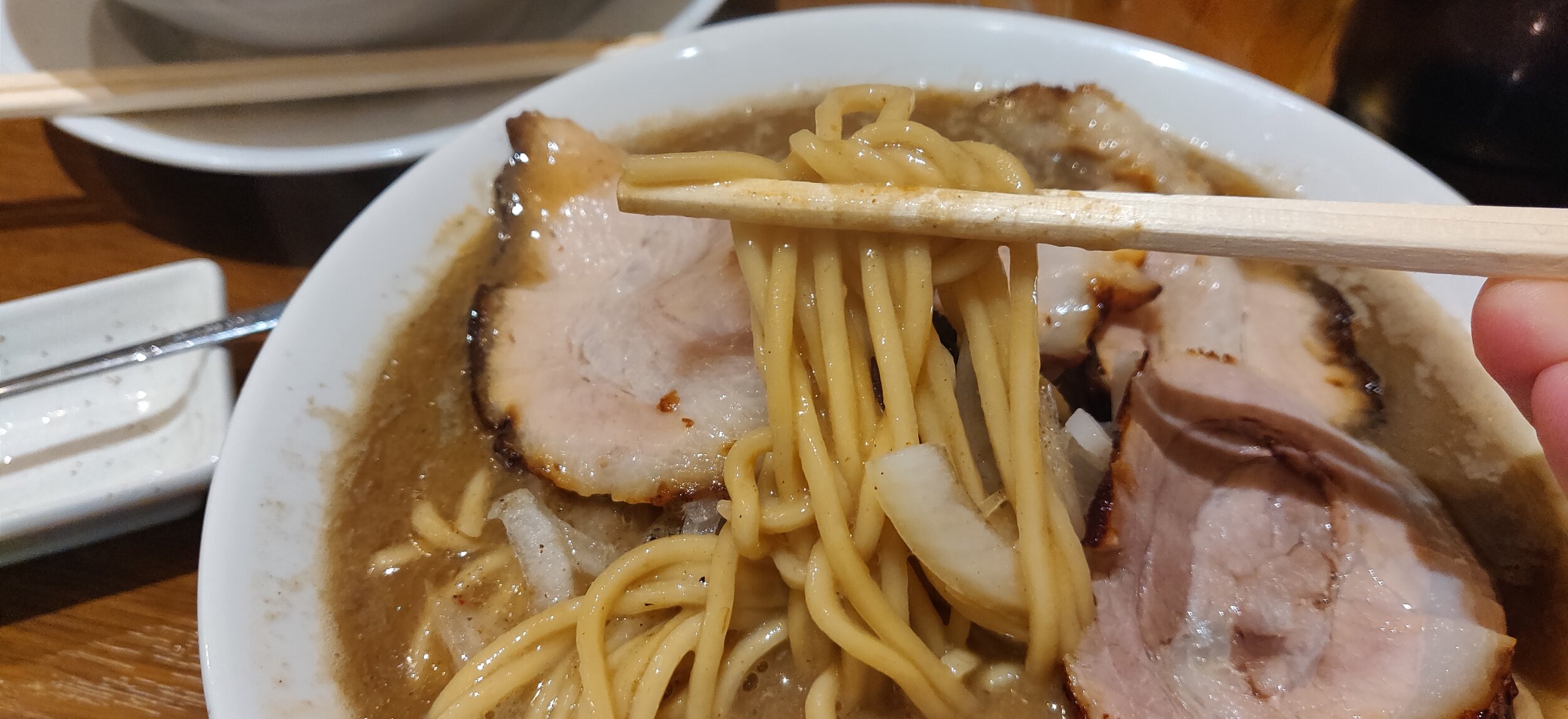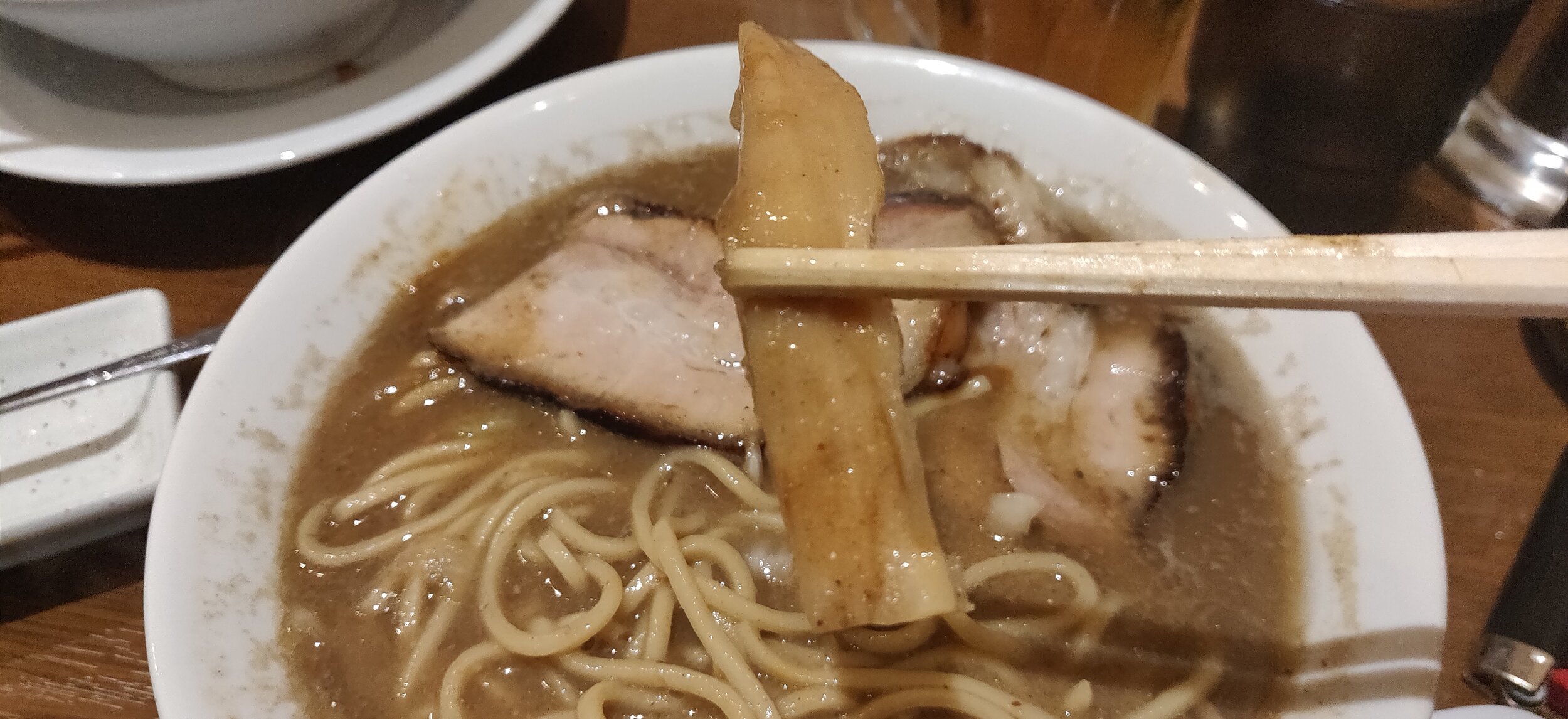(CLOSED) Men Garage Niku wo Miru (麺GARAGE 肉ヲ見ル); Brazilian Churrasco Ramen, Sangenjaya, Tokyo
I’m always on the look out for unique and interesting ramen shops around Tokyo and a friend/frequent collaborator for my ramen adventures, NamaJapan, suggested we come to this joint near Sangenjyaya station when fellow ramen instagrammer @Ramen__addict was in town visiting Tokyo. What makes Men Garage Niku wo Miro so unique is their use of Brazilian style Churrasco in place of a traditional pork char siu. The flavors are every bit char siu, but the cooking style gives it a fun and delicious twist to the traditional topping. Seating is quite spacious so if you’re coming in a large group, this might be the shop to check out. The three of us sat comfortably in one of the tables, but you can easily connect them together to fit six. No ticket machine here so you’ll have to order with the waiter, but the owner is pretty foreigner friendly and they have menus posted around the shop that you can point and choose from.
The names of the ramen are listed in English, as you can see above, so I’ll just give you a quick run down of what each ramen variety entails and what to get if it’s your first time. The ramen varieties Men Garage has to offer is the Tsukesoba, Niboshi Ramen, Gyokai Ramen, and the Shiru Nashi ramen. The most popular and recommended menu item is the Niboshi Ramen. They go quite heavy on the Niboshi so be prepared for an umami flavor bomb. Anyways, I’ll start with the Tsukesoba and go clockwise to explain what’s written. The Tsukesoba uses hand rolled noodles (手打ち) and has a light dipping soup with the broth comprised primarily of dried Bonito and various animal stock. Tsukesoba is used interchangeably with Tsukemen, so this right here is their rendition of the Tsukemen. The Shiru Nashi is the no soup variety and it comes in two flavor types; Spicy Keema Curry and the Nibo Nibo Abura Soba (Niboshi based, only available for lunch). Noodles used are the same as the Tsukesoba in which they are hand rolled. The Gyokai Ramen is a blend of Bonito and animal broth with an Oshon flour based noodle which comes in medium thickness. You can choose between a regular or a spicy version for this dish. Finally, the most recommended menu item which is the Niboshi Ramen is a self proclaimed mud soup (signifying it’s thick consistency) made with a Niboshi and sardines broth blend.
For each ramen variety, you can decide from either Nami (並, regular) or Chu (中, medium) which correlate to the noodle amount and extra toppings of Soft Boiled Egg (味付け玉子), Menma (メンマ), Cheese (チーズ), Raw Egg (生卵), Side of Rice in two sizes (ライス), and Kaesoba (変えそば). The rice isn’t listed for the Tsukesoba, but I’m fairly sure you can order it if you’d like. Each ramen comes with the signature Brazilian Churrasco char siu, but you can order up to 1000g or 1kg as seen in the top left menu leaflet. They carve the char siu at the table so let them know while they’re carving in to your bowl if you want some extra. I forgot to take a picture, but they also have some drinks and sides, one of which was a Niboshi Shochu using a Niboshi broth as mixer with the Japanese Shochu alcohol. Wasn’t particularly my favorite cocktail, but definitely something unique that I recommend trying if it’s your first time. You can always wash it down with some beer later if you find that flavors weren’t to your liking.
As you can see from above, I decided on the medium sized Niboshi Ramen with the normal amount of the Brazilian Style pork char siu. The soup is quite dense and thick, a common characteristic of long simmered Niboshi broths. In addition to the char siu, the bowl comes adorned with some thinly slice onions and some menma bamboo shoots. While the soup is distinctly Niboshi, it doesn’t quite go as extreme as a Hiwamatanoboru or an Ibuki, but rather go a bit milder towards the realm of Ramen Koike. The soup is rather oily which was a bit of a surprise as it’s not something particularly common with Niboshi ramen, but it was definitely a pleasant surprise and loved the consistency it provided to the soup. The difficulty in making this type of soup is the balance in umami and bitterness. You don’t want to completely rid the soup of any bitterness as that’s one of the characteristics people quite enjoy about Niboshi, but at the same time it has to be palatable or else it’ll be a nightmare trying to finish a bowl. Men Garage strikes a good balance, but it does come with sacrifice. If you are a fan of the deep bitter, umami enriched flavors shops like Ibuki and Hiwamatanoboru provides, this is not the shop for you. Rather it provides the umami, but in a mellowed flavor. I think that’s one of the reasons why the aroma oil is so prevalent as it will help mask and hide the niboshi-ness, if you will, of the broth. If you do miss the fish-y flavors, Men Garage provides some niboshi enriched vinegar on the table that you can add to your bowl. Not only does it give it that extra umami flavor, the vinegar helps cut through the oiliness of the soup and char siu to give it a subtle flavor change mid bowl. Definitely add some sparingly at first as it can be a lot to handle if you add in too much.
Noodles were great with the distinct Oshon flour aroma and flavor. If you’re not familiar, Oshon is a popular flour blend used by a ton of higher end ramen restaurants in Japan. It gives a much more distinct smell and the texture is chewier and firmer than if you were to use just regular white flour. I’ve realized that a lot of noodles using Oshon have a yellow/brown hue to it, but I can’t say for sure if it’s from the flour or other factors. Will say though, it definitely ups the ramen quality with the Oshon and it paired very well with the Niboshi soup. Menma bamboo were quite typical, had a bit of flavor marinated in to them, but also soaked up a ton of the soup flavors as well. They had some great crunch to them and if I recall correctly, you can order them on the side which would be perfect as an appetizer with an ice cold glass of beer. The thin raw onion slices are much needed and while most shops will use diced onions, I quite liked the texture the thin sliced version provided. It will tangle with the noodles which makes it easier to have at the same time, rather than scooping diced onions in to your mouth. Highlight here though has definitely got to be the Brazilian Churrasco style char siu. The pork cooked on the traditional skewers have the iconic Brazilian Churrasco aroma and flavors while still pairing incredibly well with the soup broth. Not sure if it was needed, but I did enjoy the little show of cutting the char siu slices at the table and adding them directly to your bowl. If you want to see what that’s like, check out NamaJapan’s video he made of the shop below.
I supplemented my bowl of ramen with the Kaedama as well, which comes as almost a side dish. The kaedama for most, if not all Niboshi ramen shops, tend to come like this in which extra noodles is served with some toppings and a bit of tare sauce underneath that you want to mix together before eating. Men Garage includes a bit of the Brazilian Churrasco scraps, thinly sliced onions, and a sprinkle of Gyofun, or dried fish powder. The Kaedama was a lot more vinergary than the ramen counterpart and I even added a bit more vinegar provided on the table to give it that acidic kick. As is, the Kaedama is fantastic and can easily stand up on its own, but adding it back in to the leftover soup makes an entirely new dish that is the perfect flavor change mid meal. The vinegar has whole niboshi soaked in it so while it adds an acidic kick, it also amps up the fish flavor. Noodles are the Teuchi, or hand rolled variety as opposed to the medium thick round noodles provided in the ramen so the subtle differences in which the noodles clasp the soup makes for an entirely new experience. If you ever find the Kaedama, or as it is sometimes called, the Aedama, here or at your local Niboshi ramen shop, definitely give it a try. Not only does it make your meal more filling, it provides an entirely new flavor dynamic that you’re not gonna want to miss out on.
Anyways, as I mentioned earlier, I went to Men Garage with NamaJapan and @ramen__addict. Check out ramenaddict’s rendition of this ramen that he created back when he got home to the States. Also be sure to check out NamaJapan’s YouTube channel. I frequently appear as a guest over on his channel so if you want to get a glimpse of me in video form, be sure to subscribe. All in all, I thought this was a great ramen restaurant to go with friends. Alcohol is cheap, ramen is delicious, you get a free show with every bowl, and seats are plentiful, making it a great atmosphere to start a night of drinking. If you’re ever in the Sangenjyaya neighborhood (which is an underrated drinking station if I say so myself), definitely check out Men Garage. If you do, let me know what you thought whether it be through my instagram @ramenguidejapan or through the comment section below.







